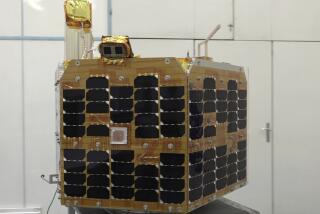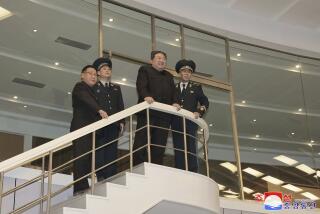Brazil’s Dream of Space Power Draws Near : Technology: Rocket launcher will give country the ability to tap into satellite market. Initial liftoff expected next year.
- Share via
ALCANTARA, Brazil — From a flat, shimmering headland overlooking the Atlantic Ocean, supersonic projectiles streak into a cloudless sky, test firings for next year’s expected launch of Brazil’s first rocket into space.
For 15 years, Brazil’s armed forces have been dreaming of a place in space. But their plans to send into orbit Brazilian-made satellites aboard Brazilian-made rockets have been delayed repeatedly by economic crisis and ostracism by developed nations suspicious of possible military use.
Now, the 20-yard tall, four-stage Satellite Launching Vehicle (VLS), emblazoned with the country’s bright green, yellow and blue flag, is near completion.
With Brazil’s recent admission to a group of nations controlling missile technology, officials say the Alcantara space facility can carve out a niche in the multibillion-dollar satellite-launching market.
They also talk of a day when space shuttles returning to earth swoop over the picturesque but crumbling remains of the nearby colonial town of Alcantara to land at the space center.
“We’re not like the Americans nor the Russians, . . . who spend billions on their space programs each year,” said Luiz Gylvan Meira Filho, president of the Brazilian Space Agency (AEB), which has an annual budget of around $200 million.
Ailing health and education systems are a higher priority for public spending than rocket technology, and the government recently opted once again to seek a foreign launcher for a new satellite rather than trying to speed up the VLS.
Of a budget of $260 million to complete Alcantara, only $150 million has so far been released, and AEB officials expect the center one day will be earmarked for privatization.
Plans for a private industrial complex to provide the center with equipment, fuel and services are nothing more than lines on a map of land recently cleared of a few quilombos, or communities of descendants of fugitive slaves. But despite its cash problems, Brazil’s space program has physics on its side.
Alcantara lies only 150 miles south of the equator, and rockets fired from its as-yet-uncompleted platforms will catch a ride on the earth’s centrifugal energy, requiring less fuel and carrying heavier loads than those launched elsewhere.
Alcantara is also ideally placed to pick up small launches that cannot be squeezed into the busy schedule of Kourou, the European Space Agency’s commercial launch center a few hundred miles north along the tropical coast in French Guyana.
The Europeans already use Alcantara for monitoring the final stages of launches of their Ariane rockets as they disappear from sight in Kourou around the earth’s curvature.
Relations with the world’s developed space-faring nations have not always been cordial, however.
“There have been lots of problems of a political nature, principally the embargo, but we’re making up for lost time,” said Jose Laundes, an air force colonel in charge of Alcantara.
Until November, Brazil was officially banned from buying missile-capable technology by the Missile Technology Control Regime, an international group seeking to restrict nuclear weapons proliferation.
Military officials strenuously deny they ever had bellicose intentions and contend Brazil was unfairly sidelined by developed nations seeking to corner the space market.
But journalist Roberto Godoy, who covered Brazil’s rocket program for 20 years, said official technology was passed to a Brazilian private arms company, which developed rockets eventually used by Iraq and Saudi Arabia in the Gulf War.
“When Brazil changed its military presidents for civilians [in 1985], the program changed radically, giving up its military aspects and dedicating itself to launching satellites,” he said.
Brazil’s inclusion in the technology regime, which followed approval by its Congress of a bill limiting sensitive defense exports, should help it purchase components still needed for conclusion of the VLS and win clients for satellite launches.
The AEB’s Meira Filho expects the VLS to make its maiden, satellite-bearing flight in 1996 and carry three additional Brazilian satellites into orbit by 2000. Two would be remote-monitoring satellites to observe forest burnings and other phenomena. The others would store data beamed into space from unmanned sites across Brazil measuring climatic change.
If a project by state telecommunications monopoly Telebras comes to fruition, 24 more satellites would be needed by 2004 to bring cellular telephone service to swathes of Brazil’s vast interior via a band of low-flying satellites.
Brazil is also involved in developing a remote sensoring satellite with China, and the AEB has set its sights on capturing a third of the international low-flying satellite market.
More to Read
Sign up for Essential California
The most important California stories and recommendations in your inbox every morning.
You may occasionally receive promotional content from the Los Angeles Times.













